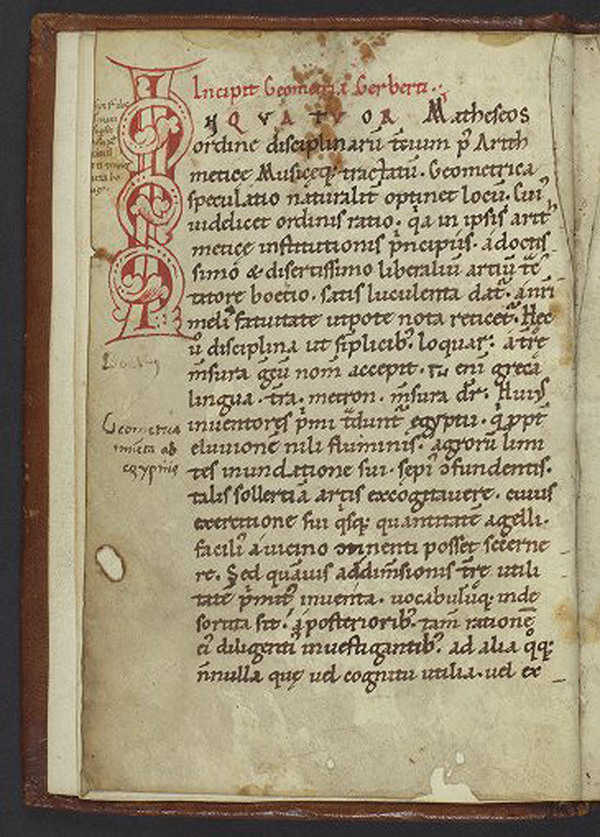- About MAA
- Membership
- MAA Publications
- Periodicals
- Blogs
- MAA Book Series
- MAA Press (an imprint of the AMS)
- MAA Notes
- MAA Reviews
- Mathematical Communication
- Information for Libraries
- Author Resources
- Advertise with MAA
- Meetings
- Competitions
- Programs
- Communities
- MAA Sections
- SIGMAA
- MAA Connect
- Students
- MAA Awards
- Awards Booklets
- Writing Awards
- Teaching Awards
- Service Awards
- Research Awards
- Lecture Awards
- Putnam Competition Individual and Team Winners
- D. E. Shaw Group AMC 8 Awards & Certificates
- Maryam Mirzakhani AMC 10 A Awards & Certificates
- Two Sigma AMC 10 B Awards & Certificates
- Jane Street AMC 12 A Awards & Certificates
- Akamai AMC 12 B Awards & Certificates
- High School Teachers
- News
You are here
Need the Area of a Triangle? The Pope Can Help! – Gerbert Finds the Area of a Triangle, Part 2: The Isagoge Geometriae
We do not know exactly when Gerbert wrote his geometry textbook—presumably a collection of lessons he had taught his students during his years at Rheims [Olleris 1867, p. 594]. In fact, these writings may have been collected after his death [Høyrup 2014]. At any rate, for much of the Middle Ages, after Boethius’ text on geometry was lost, Gerbert’s textbook was the only Latin geometry text available for the many cathedral and church schools. Figure 6 [Swetz 2019] shows the first page of Gerbert's Isagoge Geometriae (Introduction to Geometry), from a 12th-century Austrian edition of the text, available in the Mathematical Treasures Collection of this journal. (There are other beautiful images from the book there, along with a copy of a page reprinting Gerbert’s famous letter to Adalbold.)

Figure 6. The first page of Gerbert's Geometria. University of Pennsylvania Libraries, reference no. LJS 194.
And so, when Gerbert taught his students how to find the area of an equilateral triangle, which method did he teach them? What method is enshrined in his geometry text—the geometrical rule, the arithmetical rule, or the hybrid rule using \(\frac{6}{7} b\) as the altitude?
Classifying triangles
When Gerbert introduced triangles in his textbook [Olleris 1867, p. 414], he classified them either by the measures of their angles:
- Orthogonius (right-angled)
- Ampligonius (wide-angled)
- Oxygonius (sharp-angled)
or by the relative lengths of their sides:
- Isopleuros (same-sided)
- Isosceles (two sides the same)
- Scalenos (no sides the same).
Today we use mostly words derived from Latin, like equilateral and acute, to describe triangles. But Gerbert, who generally wrote almost exclusively in Latin, used Greek words here: they are exactly the same words Euclid used 1300 years earlier [Fitzpatrick 2008, p. 6]. He used the word cathetus, also from the Greek, for the altitude of a triangle.
Finding the area of an “isopleuros” triangle
Prof. Alexandre Olleris, in his edition of Gerbert’s Geometria [Olleris 1867], divided the text into very small chapters, each a paragraph or two long, on one topic. Chapter 49 (p. 450) has this heading:
XLIX. Trigoni isopleuri, cujus sunt singular latera XXX, embadi pedes comprehendere,
or, roughly,
To understand how to find the area of an equilateral triangle, each of whose sides is 30 feet.
We have seen this problem before; this is the problem Gerbert posed to Adalbold in his letter.
Here is an outline of Gerbert’s solution:
- First we must find the altitude:
- Multiply the side by itself: \(30 \cdot 30 = 900\).
- Deduct a quarter [of the result]: \(900 - \frac{900}{4} = 900 - 225 = 675\).
- Which, if you add 1, gives 676.
- And the square root of 676 is 26.
- Ecce cathetum! Behold the altitude!
- Therefore, to find the area, multiply \(\frac{1}{2} \cdot 30 \cdot 26 = 390\).
So now we see where Gerbert got the number 26 for the height of this triangle. But what exactly was he doing? Deduct one-fourth? Add 1? What is this algorithm? Was he completing the square? Or something else?
Actually, up to the point at which Gerbert added 1, he was absolutely correct. He was trying to say, without modern notation, or a complete understanding of irrational numbers, that the altitude of an equilateral triangle of side \(b\) is \(\frac{b}{2} \sqrt{3}\). But then he pulled a fast one on us. He didn’t have a number at his disposal that meant “the square root of 3.” He could not find the square root of 675. So he just found the nearest whole number whose square root he did know and used it. If the side of the triangle had been 29, or 31, this trick of adding 1 would not have worked.
By the time Gerbert wrote to Adalbold, he had presumably figured out that, by using \(\frac{6}{7}\) in place of \(\frac{\sqrt{3}}{2}\) (or, in other words, using \(\frac{12}{7}\) as an approximation for \(\sqrt{3}\) [Folkerts and Hughes 2016, p. 48]) he would be dealing with purely rational numbers and could obtain an answer.
Betty Mayfield (Hood College), "Need the Area of a Triangle? The Pope Can Help! – Gerbert Finds the Area of a Triangle, Part 2: The Isagoge Geometriae," Convergence (November 2022)




